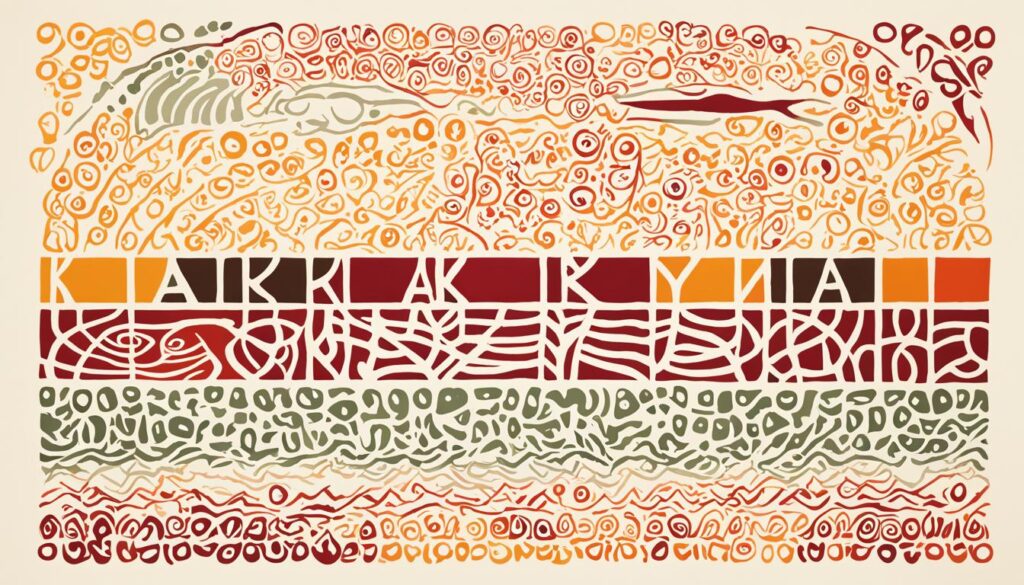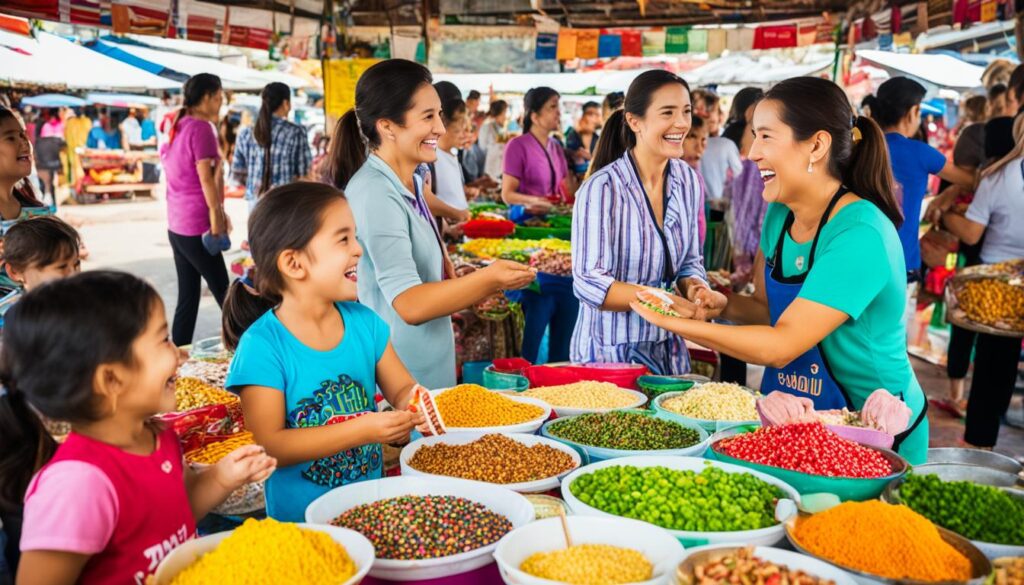Did you know that the Kaya Karen Language is spoken by approximately 4.5 million Karen people in South-eastern Myanmar and Western Thailand? This unique language, part of the Karenic branch of Sino-Tibetan languages, offers a fascinating insight into Thailand’s linguistic diversity. If you’re curious about the Kaya Karen Language, its history, and its significance, you’ve come to the right place.
The Karen Languages and Their Affiliation
The Karen languages are a group of tonal languages spoken by the Karen people. They are part of the Sino-Tibetan language family, although their precise affiliation within this family is unclear. The Karen languages are written using the Karen script.
The three main branches of the Karen languages are:
- Sgaw (commonly known as Karen)
- Pwo
- Pa’O
Karenni (also known as Kayah or Red Karen) and Kayan (also known as Padaung) are also considered branches of the Karen languages.
Classification of the Karen Languages
The classification of the Karen languages has been the subject of scholarly debate. While earlier classifications placed the Karen languages in a separate Tibeto-Karen branch, this classification is no longer widely accepted. Some modern classifications divide the Karen languages into Northern, Central, and Southern branches, based on phonological innovations and geographical distribution.
Karenic Branches
The Karenic branches within these classifications include:
| Northern Branch | Central Branch | Southern Branch |
|---|---|---|
| Pa’O | Pwo | Kayan |
| Lahta | Yinbaw | Yintale |
| Western Kayah | Eastern Kayah | Geba |
| Bwe | Paku | Geker |
| Kayaw |
These branches represent the various subgroups within the Karen language family, each with its own unique characteristics and dialects.
“The Karen languages exhibit fascinating linguistic diversity, reflecting the rich cultural tapestry of the Karen people.”

The Kaya Karen Language and its Subgroups
The Kaya Karen Language, also known as Kaya Karen, is a subgroup of the Karenic branch. It is primarily spoken by the Karenni people in the Kayah State of Myanmar. The Kaya Karen Language has several dialects within its subgroup, but they are all mutually intelligible with only slight variations in pronunciation and vocabulary. Some of the dialects of Kaya Karen include Kaya, Kayo, and Kayin Phyu.
The Kaya Karen Language plays a significant role in the cultural and linguistic landscape of Thailand. It is an integral part of the Karenic languages, a branch of the Sino-Tibetan language family. The Karenic languages, including Kaya Karen, are known for their tonal nature and unique grammatical features. These languages have rich oral traditions and are of great importance to the Karen people.
The Kaya Karen Language holds immense cultural value for the Karenni community, reflecting their identity, history, and shared experiences. It serves as a means of preserving and transmitting cultural heritage from one generation to the next.
In-depth knowledge of the Kaya Karen dialects is crucial for researchers, linguists, and anyone interested in understanding the linguistic diversity of Thailand. While the dialects may vary slightly, speakers of different Kaya Karen dialects can understand each other without major difficulties. This linguistic coherence contributes to the strong sense of unity among the Karenni people.
| Kaya Karen Dialect | Region |
|---|---|
| Kaya | Kayah State, Myanmar |
| Kayo | Kayah State, Myanmar |
| Kayin Phyu | Kayah State, Myanmar |
Exploring the Kaya Karen dialects provides a fascinating glimpse into the rich linguistic landscape of Thailand. Whether studying the language for research purposes or immersing oneself in the vibrant culture of the Karenni people, the Kaya Karen Language offers a unique and rewarding experience.
Language Diversity in Thailand
Thailand is known for its rich linguistic heritage, with a diverse range of languages spoken throughout the country. It is home to over 71 living languages, reflecting the ethnic diversity and cultural richness of Thailand.
The majority of the population in Thailand speaks Central Thai, which is also the official language of the country. However, there are numerous other languages spoken by different ethnic minority groups, each with its own unique characteristics and cultural significance.
Some of the prominent languages spoken by ethnic groups in Thailand include:
- Isan: Spoken in the northeastern region of Thailand, Isan is a language closely related to the Lao language.
- Northern Thai: Also known as Lanna, Northern Thai is spoken in the northern part of Thailand and shares similarities with the Thai language.
- Southern Thai: Spoken in the southern region of Thailand, Southern Thai has its own distinct dialects and variations.
- Karen: The Karen languages are spoken by various ethnic Karen groups in Thailand, with different branches including Sgaw, Pwo, Pa’O, Karenni, and Kayan.
- Mon: The Mon language is spoken by the Mon ethnic group, primarily in the central and western parts of Thailand.
These are just a few examples of the diverse range of languages spoken in Thailand. The linguistic diversity in the country reflects the vibrant cultural tapestry and the unique identities of different ethnic communities.

The preservation and promotion of these languages are of paramount importance in maintaining cultural heritage and fostering inclusivity within Thai society. Efforts are being made to document and revitalize minority languages through language programs, educational initiatives, and cultural preservation projects.
“Language is the road map of a culture. It tells you where its people come from and where they are going.” – Rita Mae Brown
Language Policies and Challenges
While Central Thai serves as the lingua franca and is widely used in education and government institutions, the linguistic diversity poses both opportunities and challenges. The recognition and preservation of minority languages often face hurdles such as language shift, lack of resources, and limited access to education in mother tongues.
Efforts are being made to address these challenges and promote language diversity through initiatives that support multilingual education, cultural exchange programs, and policies that value the linguistic rights of ethnic minority communities.
| Language | Number of Speakers |
|---|---|
| Central Thai | Approximately 50 million |
| Isan | Approximately 20 million |
| Northern Thai | Approximately 6 million |
| Southern Thai | Approximately 4 million |
| Karen | Approximately 1 million |
| Mon | Approximately 800,000 |
Conclusion
The Kaya Karen Language holds immense significance in Thailand’s linguistic heritage, serving as a representation of the language and culture of the Karenni people. For individuals aspiring to learn the Kaya Karen Language, there are a plethora of language resources and learning materials available to aid their journey. By delving into the depths of the Kaya Karen Language, learners can gain a profound understanding of Thailand’s unique linguistic heritage and foster connections within the Karenni community.
Learning the Kaya Karen Language opens up a doorway to explore the rich tapestry of Thailand’s multicultural society. It provides an opportunity to embrace the diversity and connect with the Karenni people on a deeper level. The availability of language resources paves the way for an immersive learning experience, facilitating language acquisition and cultural appreciation simultaneously.
Embarking on the journey to learn the Kaya Karen Language is not only a personal growth endeavor but also a testament to fostering inclusivity and celebrating Thailand’s linguistic mosaic. Whether one aims to communicate with Karenni locals, engage with Karenni traditions, or simply expand their linguistic repertoire, the resources and learning materials available make the process accessible and enjoyable. Through learning the Kaya Karen Language, we can embark on a transformative exploration of culture and language, enriching our understanding of both Thailand and the Karenni people.
FAQ
What is the Kaya Karen Language?
The Kaya Karen Language is a part of the Karenic branch of Sino-Tibetan languages spoken by the Karen people in South-eastern Myanmar and Western Thailand.
How many Karen languages are there?
The Karen languages consist of three main branches: Sgaw, Pwo, and Pa’O. Other branches include Karenni and Kayan.
What is the classification of the Karen languages?
The classification of the Karen languages has been the subject of debate, but modern classifications divide them into Northern, Central, and Southern branches.
What are the dialects of the Kaya Karen Language?
The Kaya Karen Language has several dialects, including Kaya, Kayo, and Kayin Phyu.
How many languages are spoken in Thailand?
Thailand is a linguistically diverse country with over 71 living languages spoken by different ethnic groups.
Is the Kaya Karen Language part of Thailand’s linguistic heritage?
Yes, the Kaya Karen Language represents the language and culture of the Karenni people and is an important part of Thailand’s linguistic heritage.
Are there resources available to learn the Kaya Karen Language?
Yes, there are language resources and learning materials available for those interested in learning the Kaya Karen Language.
